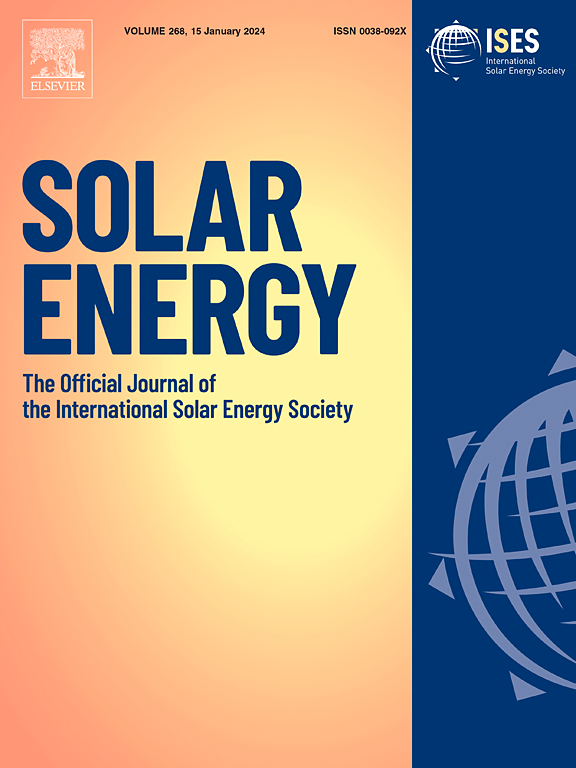Designing and optimizing the lead-free double perovskite Cs2AgBiI6/Cs2AgBiBr6 bilayer perovskite solar cell
IF 6
2区 工程技术
Q2 ENERGY & FUELS
引用次数: 0
Abstract
Due to their potential to be an absorber layer in perovskite solar cells with cheap cost, outstanding stability, and high efficiency, lead-free double perovskite Cs2AgBiI6 and Cs2AgBiBr6 have attracted tremendous attention recently. In this work, Cs2AgBiI6 and Cs2AgBiBr6 are introduced to create a perovskite-perovskite bilayer solar cell FTO/ETL/Cs2AgBiI6/Cs2AgBiBr6/HTL/Au through SCAPS-1D. The Cs2AgBiI6/Cs2AgBiBr6 double absorber layer structure significantly reduces lead toxicity while improving the device’s stability and light absorption capabilities, according to the results. We chose the optimal hole transport layer (HTL) and electron transport layer (ETL) to examine the impacts of several HTLs and ETLs on the PSC. The device’s performance appears to be significantly impacted by the energy level alignment of the absorber and transport layers, and that ideal energy band structure facilitates the carriers’ transportation and separation. Through numerical simulations, the impacts of some factors containing the absorber layer thickness, defect density and doping concentration of the perovskite layers, operating temperature, and different back-contact electrodes, were examined. The optimized results are PCE = 34.36 %, FF = 93.35 %, Jsc = 24.78 mA/cm2, and Voc = 1.48 V. This work demonstrates that double perovskite Cs2AgBiI6 and Cs2AgBiBr6 hold great potential for application in photovoltaic and optoelectronic devices.
设计和优化无铅双包晶 Cs2AgBiI6/Cs2AgBiBr6 双层包晶太阳能电池
无铅双包晶石 Cs2AgBiI6 和 Cs2AgBiBr6 具有成本低廉、稳定性好、效率高等特点,可作为包晶太阳能电池的吸收层,因此近年来备受关注。在这项研究中,我们引入了 Cs2AgBiI6 和 Cs2AgBiBr6,通过 SCAPS-1D 制作了一种包晶-包晶双层太阳能电池 FTO/ETL/Cs2AgBiI6/Cs2AgBiBr6/HTL/Au。结果表明,Cs2AgBiI6/Cs2AgBiBr6 双吸收层结构显著降低了铅毒性,同时提高了器件的稳定性和光吸收能力。我们选择了最佳空穴传输层(HTL)和电子传输层(ETL),考察了几种 HTL 和 ETL 对 PSC 的影响。器件的性能似乎受到吸收层和传输层能级排列的显著影响,理想的能带结构有利于载流子的传输和分离。通过数值模拟,研究了吸收层厚度、过氧化物层的缺陷密度和掺杂浓度、工作温度以及不同背接触电极等因素的影响。优化后的结果为:PCE = 34.36 %,FF = 93.35 %,Jsc = 24.78 mA/cm2,Voc = 1.48 V。这项研究表明,双包晶石 Cs2AgBiI6 和 Cs2AgBiBr6 在光伏和光电设备中具有巨大的应用潜力。
本文章由计算机程序翻译,如有差异,请以英文原文为准。
求助全文
约1分钟内获得全文
求助全文
来源期刊

Solar Energy
工程技术-能源与燃料
CiteScore
13.90
自引率
9.00%
发文量
0
审稿时长
47 days
期刊介绍:
Solar Energy welcomes manuscripts presenting information not previously published in journals on any aspect of solar energy research, development, application, measurement or policy. The term "solar energy" in this context includes the indirect uses such as wind energy and biomass
 求助内容:
求助内容: 应助结果提醒方式:
应助结果提醒方式:


